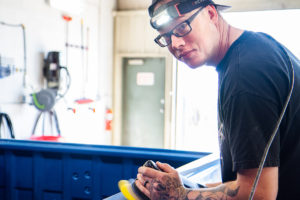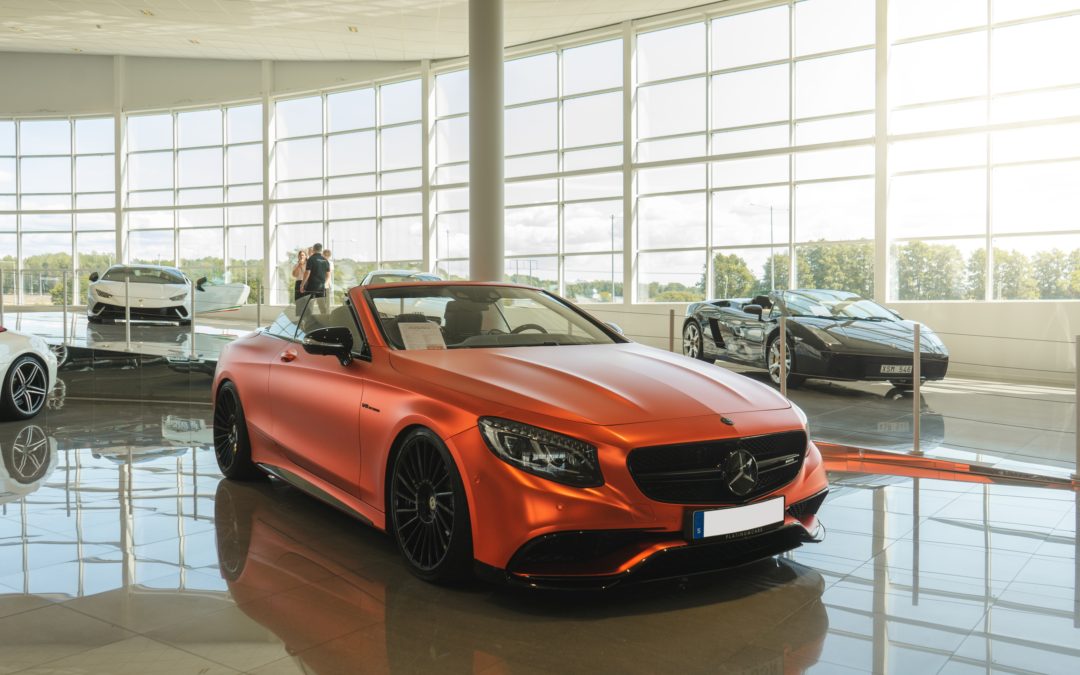By Kevin Balmer, CD, Sindicate Auto Salon, Red Deer, Alberta, Canada
Photo by Isak Pettersson on Unsplash
Have you just purchased a new vehicle, or are you planning to? We’re going to help you feel confident in your decision to protect your investment. By understanding protection options and how they can help you, you can make your own decisions to help maintain appearance and value on your new vehicle.
In this guide we will be discussing the paint conditions on new vehicles, options for protection, how to choose the right product and installer, and tips for outsourcing protection from the dealership (even if you’re financing).
Let’s start by looking at what to expect with the new paint on your vehicle.
Condition of New Vehicle Paint
When it comes to the condition of new vehicle paint, it’s important to understand that it may not be as flawless as you hope.
While noticeable defects should be corrected within quality control during manufacturing, the paint typically leaves as “passable”, not perfect. Even high-end luxury cars rarely arrive with “perfect” paint, especially in the eyes of an experienced detailer who can spot imperfections.
Also, improper washing can cause swirls on the paint. Before the new vehicle is in your possession, it will have been washed multiple times by many people, from transport to sitting in a dealership lot.
Dealerships, or inexperienced personnel, are notorious for causing fine marring or swirls in the paint from poor washing methods.
The exterior may also have iron fallout from transporting, which can cause what look like small rust spots (most visible on white). To remedy these issues, a professional detailer can help.
Removing Defects in Factory Paint
To achieve a flawless finish on your vehicle’s paint, there are two main options to consider: single-stage polishing or multiple-stage paint correction, also known as a cut and polish.
Single-stage polishing, or enhancement polishing, is a less abrasive option that aims to reduce 60-70% of minor defects. This makes it ideal for new vehicles that commonly have fine marring (small, superficial scratches or swirls). For further fine-tuning, whether that’s due to your expectations or what’s required due to the condition of the paint, multiple-step paint correction is best.
Paint correction involves a multi-step polishing process that begins with a compounding stage (sometimes called cutting) to remove microscopic layers of clear coat to reduce or eliminate deeper defects. This approach can remove up to 90-95% of defects in the paint, including light scratches, swirls, and orange peel surfaces, resulting in a smooth finish.
For new vehicles with minor defects, a single-stage polish is typically enough. However, to achieve the best results, the extent of correction will depend on the condition of your paint and your own expectations.
It’s important to note that the correction process requires skill and experience. If done incorrectly, it can result in an inconsistent or unappealing finish.
Once the surface is perfected, it’s important to protect it with reliable, long-term protection to maintain its new look.
What is the best way to do this?
Preserving Your Paint
As factory paint has become thinner, aftermarket protection has become increasingly important. Thin paint is more vulnerable to damage, and it doesn’t take long for rock chips or wear to show. In fact, damage can occur in as little as a few weeks.
Even a quality, custom paint job with sufficient paint isn’t immune to damage from road debris, rock chips, and the elements. This damage, such as rock chips, fading, swirls, or marring, can ruin the overall appearance and really fast-track depreciation. If left neglected, it may even result in a costly paint correction or repaint.
To maintain your vehicle’s value and appearance, it’s essential to practice preventative maintenance. Fortunately, aftermarket protection options have advanced over the years, and when professionally installed and of high quality, they can last a long time. This is great news for consumers, but it’s even more crucial to ensure that the preserved surface is free of defects or imperfections; otherwise, they will be locked in long-term.
For instance, if there are already rock chip damages present on the surface, applying paint protection film over it will lock in the damage, which will be visible through the film.
If you address any defects before applying any protective films or coatings, you can maintain your vehicle’s beautiful finish for years to come.
Your Options for Protection
Paint Protection Film (PPF) and Ceramic Coatings are two of the most effective options for protecting and preserving your vehicle’s paint. PPF is designed to provide tough protection on high-impact areas, while ceramic coatings shield the paint with a clear, hard shell that resists UV and contamination from the environment.
Rock Chip/Impact Protection
PPF provides a long-term, sacrificial film barrier that protects your paint from impact damage caused by road debris and weather conditions, as well as harmful UV rays.
Depending on your needs, you can choose to protect anywhere from high-impact areas like the front end, to the entire painted exterior. Partial front-end coverage, including the front bumper, partial hood, partial fenders, and mirrors, is most common, but extended front-end coverage or other high-impact areas, such as above the windshield or along the rockers, should be considered to maintain more value.
If you’re unsure which areas to protect, consider your previous vehicles and where you noticed the most wear or buildup. You can also consult with a PPF specialist to determine the best options for your vehicle.
When choosing a PPF brand, it’s important to select a quality, warrantied product.
UV/Contaminants Protection
Want to avoid surface damage caused by the sun, brake dust, bird droppings, insects, road salt, and more? Ceramic coatings are liquid polymers that chemically bond to the surface, forming a smooth, glass-like protective layer. Their longevity and durability make them more appealing than a traditional car wax. Once applied, the surface becomes hydrophobic and stain-resistant for years, while also creating a unique gloss and depth in the paint.
When selecting a ceramic coating, consider the duration of protection you need. Coatings are offered in varying durations, and you should choose one based on how long you plan to keep your vehicle. If you keep your vehicle longer than you initially thought, you can always opt for another coating application after the lifespan of your current coating.
The quality of the ceramic coating and the installation process is crucial for reliability. Products available to anyone are usually more forgiving in nature to allow room for installer-error, which can result in a lack of durability. To promote a proper bond, it’s also important to ensure that the surface is properly prepped with an extensive decontamination and, ideally, polishing the surface. This will also ensure that you’re happy with the look for years to come, since the coating will lock in the current condition of the surface below.
Don’t fall for common myths such as ceramic coatings being bulletproof, eliminating the need for regular washing, hiding scratches or bad paint, or lasting a lifetime. Instead, opt for a high-quality product and regularly maintain your coating to ensure its effectiveness.
Ceramic coatings can be applied over PPF, but they must be installed last for the film to stick to the surface due to the hydrophobic properties of ceramic coatings.
Combining PPF and ceramic coatings provides an excellent option for tough protection on high-impact zones and an all-over shield from everyday contaminants. By understanding the benefits of PPF and ceramic coatings, you can make an informed decision on the best options for protecting your investment.
Other Overlooked Protection
Protecting your vehicle’s paint is important, but don’t overlook other areas that can benefit from protection.
Ceramic coatings can be used on wheels, plastic trim, and interior fabrics. PPF can also be applied on headlights and fog lights to preserve costly lenses.
Additionally, aftermarket window tint helps protect the interior too. It’s more than an aesthetic upgrade; it will also block 99% of harmful UV rays that can damage your interior and its passengers. Factory tinted glass does not provide UV protection, so consider aftermarket tint to add protection.
What Options Are Best For You?
When deciding on protection options, it’s important to consider your individual situation and priorities. Will your vehicle be exposed to harsh conditions or terrain? What types of damage have you experienced in the past? What is most important to you in terms of preserving your vehicle’s appearance and value?
Asking yourself these questions can help you determine which options will be most effective for your needs. For example, if you use your vehicle for work or commuting, reliable protection may be more important than a “showroom” finish. On the other hand, if you have a special or high-end vehicle, long-term, extensive protection may be a top priority to maintain its appearance.
Be sure to communicate your goals and expectations to your detailer and film installer. With this information, they can help you develop a customized plan that meets your specific needs.
Dealership Protection vs. Outsourced Protection
Some dealerships are (unfortunately) known for offering questionable products with high-pressure sales tactics, which can make it difficult to determine what’s truly in your best interest. However, armed with knowledge of new vehicle protection options and what to expect, you can confidently navigate the options available during the purchase process and do your own research on what’s available, whether that’s through the dealership or elsewhere.
To find the best value for your vehicle protection, ask for estimates from both the dealership and other local, reputable shops. Don’t rely on price alone – clarify what’s included and compare protection options, brands, and prices. Ask about the service breakdown, products used, and their warranty.
To ensure a professional installation, ask about the installer’s experience and request to see a portfolio or chat with them. Compare the estimates, products, qualifications, and customer service/assistance you received.
Remember, your options are not limited to the dealership. You can choose to take your business elsewhere if you prefer, even if you’re financing. In most cases, you can find the same protective coverage for a fraction of the cost at a higher quality and installed by experienced technicians.
By keeping these points in mind, you can ensure that you’re getting the best value for your vehicle protection and that you’re making informed decisions when choosing a protection shop.
Finalizing Your Plan
After asking the important questions and researching the product and installation qualifications, it’s time to finalize your plan.
Schedule Protection ASAP
Schedule protection services as soon as possible to avoid any damage to your new paint. New paint is thinner and can be easily damaged, which is why it’s crucial to arrange protection in advance and schedule an appointment shortly, if not immediately, after picking up the vehicle.
Make sure your detailer and film installer understand your full expectations to formulate a plan and timeline accordingly.
Warranty & Aftercare
It’s important to ask about the warranty and aftercare of the protection products you choose. Most of these products require regular upkeep and maintenance to perform at their best and get the maximum life out of them.
Ignoring suggestions can disrupt the initial curing process, or bad habits could lead to lost benefits or even product failure. Therefore, it’s important to know the warranty and what it includes, and to make sure you’re meeting the requirements or if there are things to avoid or watch for.
Following aftercare instructions will help maintain the longevity and effectiveness of the product.
Conclusion
Buying a new vehicle can be stressful, but with the right information, you can feel great about your new ride! By becoming educated about the process, you will feel confident when considering your options to maintain the value of your new vehicle purchase.
Do your research, get familiar with what’s available, and seek assistance from experienced industry professionals. A professional who is passionate about their services will be happy to give guidance and help avoid misconceptions or gimmicks.
Remember, a little effort and investment today can go a long way towards keeping your vehicle in top condition to maintain appearance and value. You’ll thank yourself for it later!

About the Author: Kevin Balmer, CD, is the Owner and Operator/Detailing Specialist of Sindicate Auto Salon in Red Deer, Alberta, Canada. The “eye of a detailer” is no joke when it comes to Kevin and his capabilities of his craft. His exceptional attention to detail is intensified by his passion for vehicles and detailing, leading to the outstanding, radiant results that he is known for. Whether it’s bringing life back to once shiny paint, or finding and correcting every possible defect — you state your expectations and Kevin will undoubtedly meet them. The level of his knowledge and skill is proven, as a SB3 Certified Technician and Red Deer’s only IDA Certified Detailer. However, the undeniable proof of talent resides in the outcome of his work.


